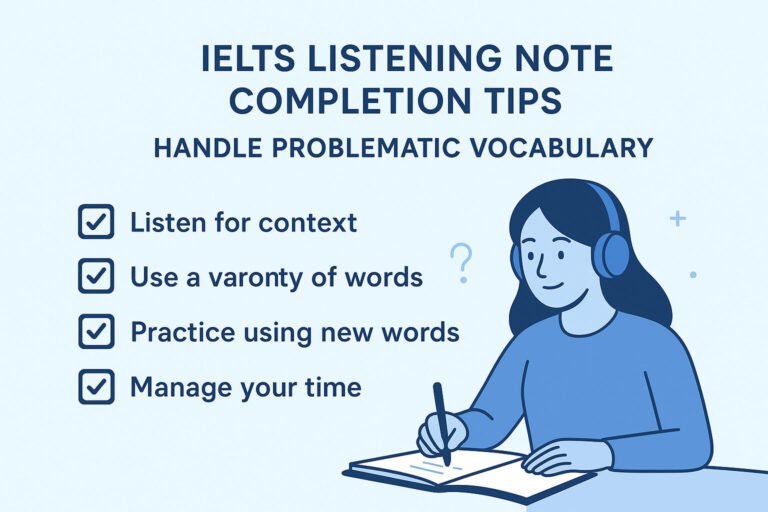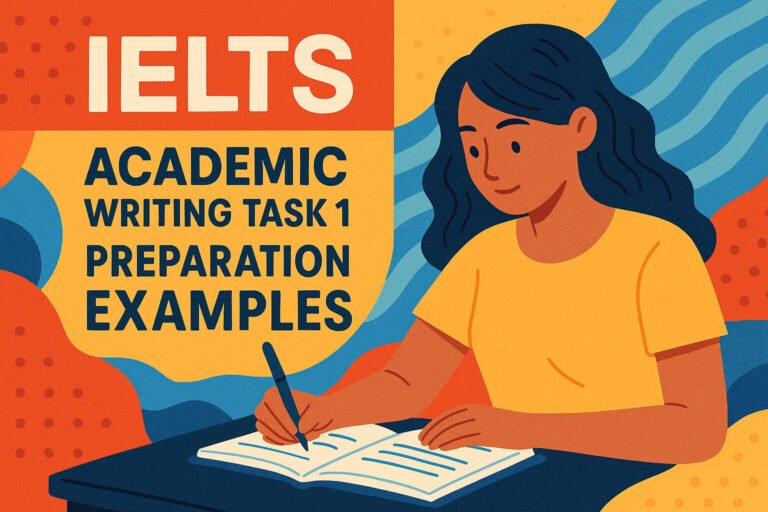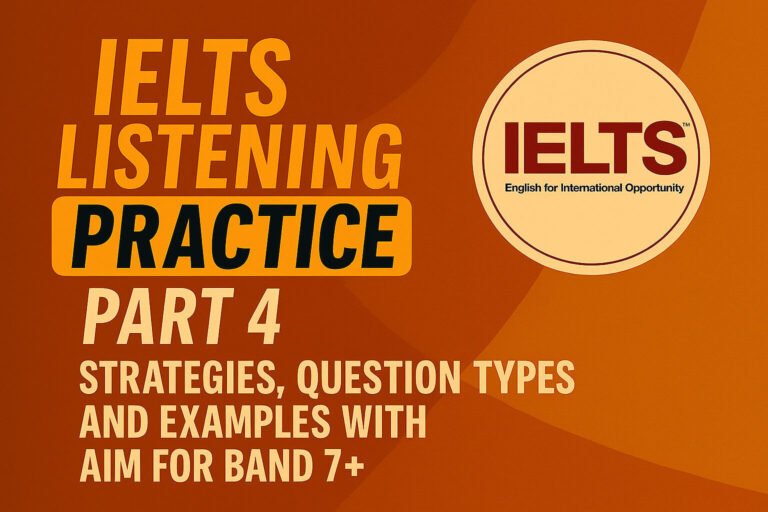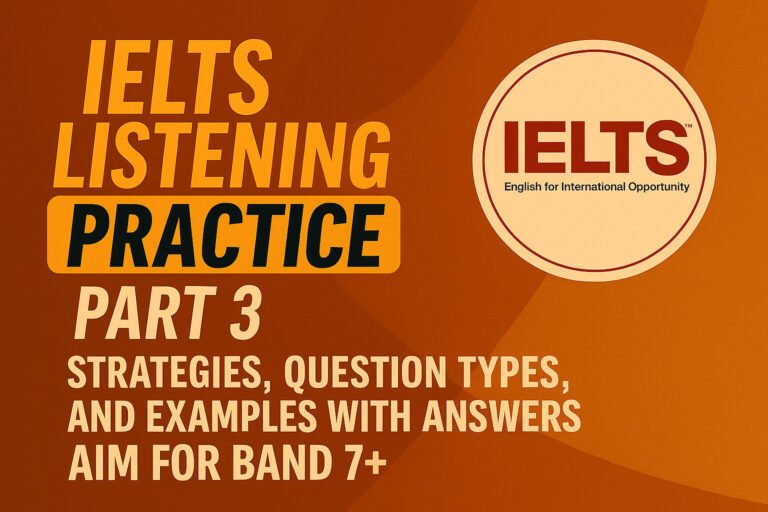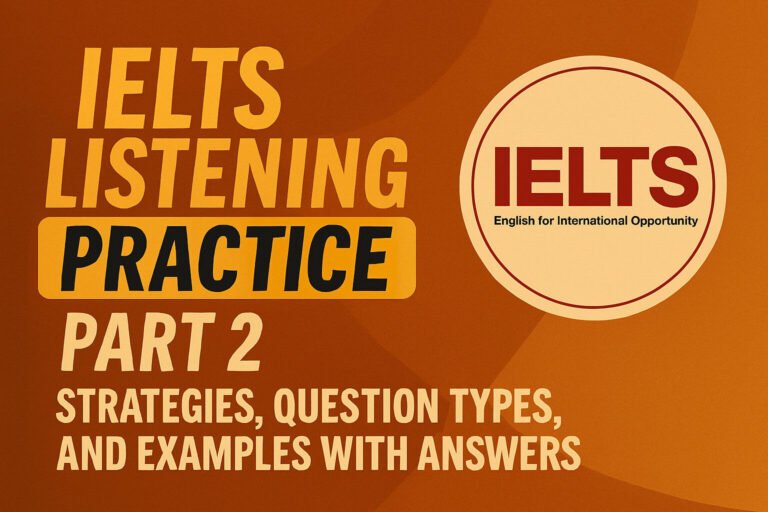Struggling to catch every word in the IELTS Listening test? Many aspirants find it challenging to follow audio tracks and answer accurately under time pressure. This guide, inspired by expert class notes, offers practical do’s, don’ts, idioms, and strategies to help you excel. Whether you’re aiming for a band 7 or higher, we’ll break down the test structure and provide actionable steps to boost your listening skills.
By the end, you’ll feel confident tackling all four parts, starting with Part 1, and turning challenges into strengths. Let’s get started!
What is the IELTS Listening Test? A Quick Guide
The IELTS Listening test lasts about 30 minutes, followed by 10 minutes to transfer answers. It includes 40 questions across four sections, played once via audio. Each section increases in difficulty, testing your ability to understand conversations, monologues, and detailed information.
- Part 1: Two speakers discuss everyday topics (e.g., booking a table).
- Part 2: A monologue on a social context (e.g., a guide talk).
- Part 3: A conversation with up to four speakers (e.g., students planning).
- Part 4: A lecture or talk (e.g., academic content).
Success depends on focus, prediction, and note-taking. This guide will help you master each part, starting with Part 1’s basics.
Key Do’s for IELTS Listening: Boost Your Performance
Class notes highlight these do’s to improve your IELTS Listening score. They focus on preparation and active listening.
- Read instructions carefully: Check word limits (e.g., “no more than two words”) before the audio starts.
- Predict answers: Look at gaps and guess possible words or numbers based on context. For Part 1 bookings, expect names or times.
- Take concise notes: Jot key words during the pause (e.g., “7 PM” for a reservation). Avoid full sentences.
- Focus on keywords: Listen for signposts like “firstly” or “however” to catch main ideas.
- Check spelling and grammar: Use the transfer time to ensure accuracy, as mistakes cost points.
- Practice with sample tests: Use official materials to get used to accents and speed.
- Stay calm if you miss an answer: Move on quickly; you can’t rewind the audio.
These do’s build a strong foundation. Practice daily to sharpen your skills.
Common Don’ts in IELTS Listening: Avoid Costly Errors
Avoid these pitfalls from class notes to keep your score on track. They can derail even the best preparation.
- Don’t lose focus: Distractions like noise can cause you to miss sections. Stay alert.
- Don’t write too much: Exceeding word limits (e.g., writing three words when limited to two) loses marks.
- Don’t guess randomly: Use context clues instead of picking any answer.
- Don’t panic over unfamiliar words: Focus on what you understand; the test isn’t about vocabulary alone.
- Don’t leave blanks: Even an educated guess is better than no answer.
- Don’t rush transferring answers: Errors here are common. Double-check during the 10-minute window.
- Don’t ignore the example: It shows the format—listen carefully.
Sidestepping these don’ts ensures a smoother test experience. Practice helps you stay composed.
Useful Idioms for IELTS Listening Context: Add Flair
Idioms from class notes can enrich your understanding of audio contexts, especially in Part 1 conversations.
- Get the ball rolling: Start something. Example: “Let’s get the ball rolling with your booking details.”
- Hit the nail on the head: Be exactly right. Example: “You hit the nail on the head with that time suggestion.”
- Break the ice: Ease initial awkwardness. Example: “A quick chat broke the ice before the meeting.”
- In the nick of time: Just in time. Example: “We arrived in the nick of time for the appointment.”
- On the same page: Agreeing. Example: “Let’s ensure we’re on the same page about the date.”
- Piece of cake: Very easy. Example: “Filling this form is a piece of cake with your help.”
- Under the weather: Feeling unwell. Example: “I was under the weather but still made it.”
Recognize these in audio to grasp speaker intent. Practice linking them to answers.
Mastering IELTS Listening Part 1: The Starting Point
Part 1 introduces the test with a conversation, often a transaction (e.g., booking or inquiry). It’s easier but sets the tone.
- Expect simple dialogues: Two speakers, clear context (e.g., hotel check-in).
- Focus on details: Listen for names, numbers, or addresses. Example: “The address is 12 Maple Street.”
- Use the pause: Preview questions and predict (e.g., a phone number might follow “call me at”).
- Watch for spelling: Proper nouns like “Smith” need accuracy.
Practice Part 1 with sample audios. Record progress to build confidence.
Strategies to Excel in All Four Parts
Each part has unique challenges. Here’s how to tackle them.
- Part 1: Predict and note key details. Use a timer for 4-5 minute practice.
- Part 2: Follow one speaker’s flow. Sketch a mental map for routes or plans.
- Part 3: Identify speaker roles (e.g., student, tutor). Note opinions.
- Part 4: Anticipate academic terms. Focus on main points, not every word.
| Part | Focus Area | Practice Tip |
|---|---|---|
| 1 | Details | Listen to daily conversations |
| 2 | Monologue | Follow podcasts or guides |
| 3 | Discussion | Record group talks |
| 4 | Lecture | Summarize TED Talks |
This table guides your practice. Consistency is key.
Advanced Techniques for Higher Bands
For band 8+, improve multitasking. Listen, read, and write simultaneously during practice.
Use synonyms to predict: “appointment” might become “meeting.” Recognize distractors—speakers may correct themselves (e.g., “No, not 5 PM, 6 PM”).
Enhance concentration with noise-canceling headphones during mocks. Record and review to refine listening skills.
Sample Practice Questions and Tips
Try these to apply strategies. Answers are contextual.
- Question: What time is the meeting? (Audio: “Let’s meet at 3 PM, no, make it 4 PM.”)
- Tip: Note the correction. Answer: 4 PM.
- Question: Where is the event? (Audio: “It’s at the community hall on Oak Road.”)
- Tip: Catch the location. Answer: community hall.
Practice 10 questions daily. Check answers to spot patterns.
Your IELTS Listening Questions Answered
How can I improve my listening skills?
Practice with IELTS sample tests and real-life audio (e.g., BBC news). Start slow, then increase difficulty.
What if I miss a whole section?
Focus on remaining parts. Use transfer time to guess missed answers logically.
Are British and American accents mixed?
Yes, expect variety. Practice both to adapt—watch shows like “Friends” or “Doctor Who.”
Can I ask to replay the audio?
No, it’s played once. Train to listen actively in one go.
How is the score calculated?
1 mark per correct answer, out of 40, converted to a band (e.g., 30/40 = band 6.5).
With these tips, IELTS Listening becomes manageable. Practice daily, stay positive, and check our other guides for full prep. Your band score awaits—go for it!


